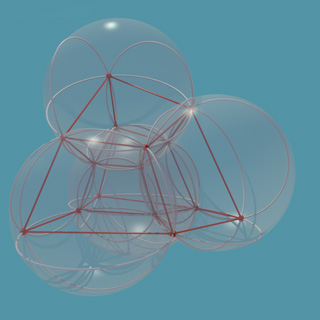
Recently it was discovered that fundamental algebraic structures of the theory of integrable systems, such as Yang-Baxter equations and quantum groups, are connected to quantization of elementary incidence theorems in three-dimensional geometry. A key role in this setting is played by circular nets in 3D (like the one shown on the picture) which provides remarkable examples of discrete Hamiltonian evolution systems.
There exists a large number of two-dimensional exactly solvable models in statistical mechanics and quantum field theory, but only a few three-dimensional examples are known. Nevertheless the later provide deep insights into mathematical structure of integrable systems. Any three-dimensional lattice model can be viewed as a two-dimensional model, where the additional third dimension is treated as an internal degree of freedom. Therefore every solution of the tetrahedron equation (3D analog of the Yang-Baxter equation) provides an infinite sequence of integrable 2D models differing in the size of the 'hidden third dimension'.
Remarkably all known solutions of the tetrahedron equation can be obtained from quantization of geometric integrability conditions for the 3D circular lattices—lattices whose faces are planar quadrilaterals inscribable into a circle. The key idea of this geometric approach to integrability of discrete systems is to utilize various consistency conditions arising from geometric relations between elements of the lattice. It is quite remarkable that these conditions ultimately reduce to certain incidence theorems of elementary geometry. For instance, the integrability conditions for the quadrilateral lattices merely reflect the fact of existence of the 4D Euclidean cube.